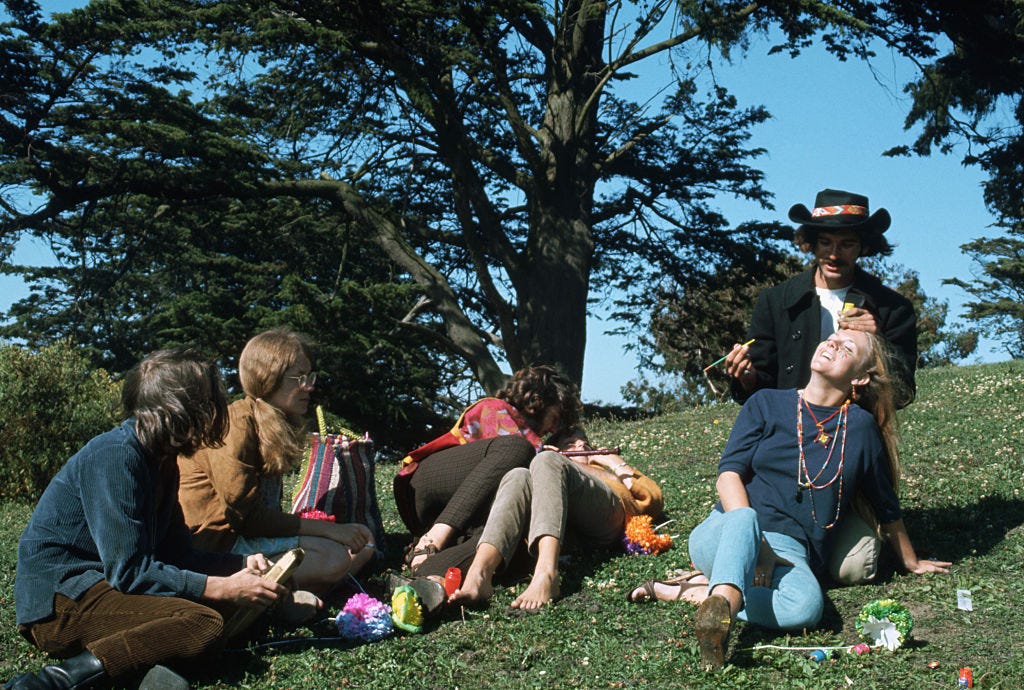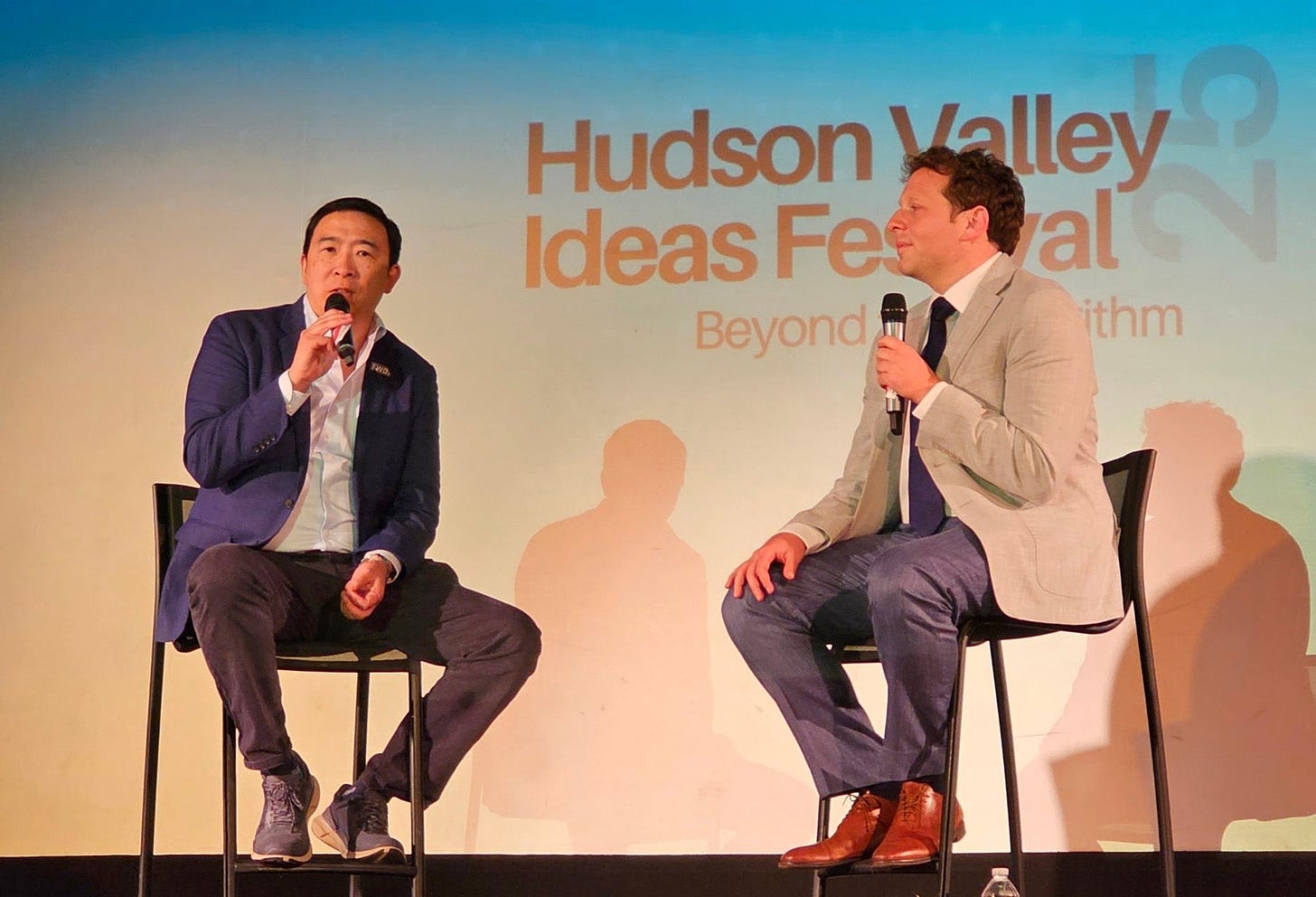The End of Bohemia
When the rents won't fall
On Saturday, I had the thrill of appearing at the Hudson Valley Ideas Festival, where I took the stage to talk on my new novel, Glass Century, and the state of American politics today. A hearty thanks to Andrew Yang for organizing the festival in Rosendale and for asking many great questions. It’s a weekend I won’t forget.
On May 6th, Glass Century arrives. Please preorder what has been called one of the great social novels of our generation. If you want to come celebrate the launch with me, there’s still room to come to my talk at P&T Knitwear, an excellent bookstore in Manhattan. You must RSVP to attend and tickets are going quite fast. Beer and wine are available.
I’ll also be in Brooklyn with the legendary John Pistelli on May 8th. Join me there, too!
In David Polonoff’s rollicking novel WannaBeat, a twentysomething named Philip Polarov tries to become a writer in 1970s San Francisco. Philip is middle-class and downwardly mobile; he went to an elite, unnamed college and the novel strongly implies he could find more gainful employment than dishwashing or sandwich-making. But for Philip, money is secondary to art—he wants to write his Great Book, which ranges, at points, from an incomprehensible stream-of-consciousness novel to a psychedelic Western of Pynchonian vintage. Philip can’t quite pull it off, and Polonoff writes exquisitely—and hilariously—on a particular kind of bohemian toil. Philip is part of a generation that lives in the shadows of both the Beats and the Summer of Love. A decade has passed since 1967, the height of Haight, Be Sure to Wear Flowers in Your Hair. Gregory Corso is stumbling, drunk and high, through the city streets. Punk is beginning to flower—Philip is wary—and the seedlings of the modern Silicon Valley are just coming into view. San Francisco is still a rough-neck sort of place, stuffed with novelists, poets, painters, and musicians, as well as the blue-collar workforce that powered the city’s wartime economy. Soon, the city’s liberal mayor, George Moscone, will be assassinated, along with a member of the Board of Supervisors who will become, in death, far more famous. Harvey Milk is on the outskirts of WannaBeat.
Philip lives cheaply in San Francisco. Part of the point is that he can—that scrounging together enough cash to take a room somewhere is no great feat, even if you’re merely washing dishes. If he never romanticizes his own artistic and economic struggles, noting the deus ex machina “escape hatches” many famed artists enjoyed— “Hemingway’s wives had trust funds and fortunes. Miller was supported by his girlfriend’s husband and his wife’s boyfriends. Burroughs’ ‘allowance.’ Pollock’s Guggenheim. Scratch the surface, and all the artists who survived bohemia kept one foot surreptitiously in the bourgeois door.”—he also occupies a world that is, in every sense, set to vanish. In the 1970s, most major American cities had large, very affordable neighborhoods. Some of this was a function of deindustrialization and the economic woes of the era; some of it was just how cities always functioned. Most urban areas were stocked with cheap apartments or single-room occupancy buildings that could accommodate many Philip Polarovs. The conditions were shabby, but the sort of street homelessness that is distressingly common in San Franciso, Los Angeles, New York, Pheonix, and a growing number of other cities today was mostly unheard of, absent the Great Depression, in the twentieth century. The reason was simple: it wasn’t that difficult to rent an apartment or a room somewhere.
My late father used to say that, when he was a young man, you could count the number of expensive New York City neighborhoods on one hand. The reverse, by his later years, was true: the affordable neighborhoods are tallied on one hand, at best. Before the pandemic, this was the reality of the coastal cities. In the early 2020s, rents surged everywhere, as demand and supply constraints drove prices upward and major money continued to flood the cities. Tech cash long ago distorted San Francisco’s rental market. And gentrification trends that once seemed unique to New York and Los Angeles seemed to take hold in most metro areas. Escaping the hottest precincts of Brooklyn didn’t suddenly guarantee you astronomically cheaper rent somewhere else. There are still cheaper, smaller cities in America, but less of them than there once were. The story of New York is now the story of Portland, Seattle, Nashville, and Austin.
What does it mean for America to lack bohemias? What does it mean, even, for a 2000-style Brooklyn arts scene—the type that fueled the indie rock boom of that era—to be effectively impossible? Elite, mainstream culture has stagnated. There are still quality movies and books released by the large conglomerates and good music that comes from the major record labels, but, like sheer number of cheaper neighborhoods, a lot less of it. As the online microculture booms, the macroculture fails to progress. I am sanguine about the green shoots, the New Romanticism and the flourishing of a writing culture here on Substack, but there are still tremendous challenges for those who want to create art. If the working-class and poor always struggled when trying to write books, paint, or make music, it was easier, in the twentieth century, to form in-person scenes, urban clusters where the creative could easily congregate. Greenwich Village, from the early 1900s to the 1990s, is the emblematic example, and similar enclaves could be found in other major American cities. Artists, certainly, were poor, but they could live in proximity to one another, scrounging up the cash for an apartment or room that would rent for a few hundred bucks or even much less. The barrier to forming a functional scene was far lower.
What this all meant, in practice, was a healthy tension between bohemia and the mainstream, the various countercultures and the suits at the top who disseminated art to the masses. If the countercultures were co-opted, art as a whole became more dynamic. A tiresome, self-satisfied Hollywood in the late 1960s gave way to New Hollywood, as young auteurs were permitted to rise and impose their own countercultural visions on a mass medium. The novel would evolve, embracing the frank sexuality of once underground and banned works—without Henry Miller’s Tropic of Cancer, it’s hard to imagine how Philip Roth’s Portnoy’s Complaint becomes a runaway best-seller. The disappearing bohemia is not merely an American phenomenon, either. A far poorer and cheaper Paris allowed locals and American ex-pats alike, including Miller, to write, paint, and mix with one another. Cities today are wealthier but more sterile, hubs of global finance that, if they haven’t snuffed out art entirely, make it so those conditions for production become far more daunting and only those with access to enough capital can dedicate years of their lives to creative pursuits.
The end of bohemia doesn’t necessarily mean permanent cultural stagnation. It is a hurdle to be overcome, since those who care about art in the 2020s know that cheap rents aren’t suddenly returning. The internet does allow for crosspollination that was not possible before; Substack is a less toxic form of the old social media, a platform for like-minded writers across the world to gather and exchange ideas. I know I’ve done this. I know, too, this isn’t always ideal; even when tech platforms are benign, they are still tech platforms, and we are digital serfs tilling someone else’s land. Substack is the best itineration we have found so far, and one that is already, nascently, inculcating its own literary scene, as John Pistelli recently argued. So far, the world of books has benefited most from the emergence of Substack. Authors can promote themselves and readers can find books they haven’t heard of otherwise. Fiction and poetry can be published readily to audiences that are, in many instances, larger than what most literary magazines and journals enjoy. The ferment will only continue. When it comes to music and film, though, it’s unclear what role Substack can play beyond offering a place for stronger and more enlivening criticism. The visual arts, similarly, aren’t yet being bolstered by the rise of this digital scene.
What has been ameliorative about Substack is that it is encouraging people to meet offline. I’ve made genuine writer friends here, and I find a Substack audience can translate to one where actual human beings have read your work and want to discuss it with you. There’s an urge, now, to use the internet as a means to congregate elsewhere. This was the original promise of the digital realm. Before social media, it was a supplement to your flesh-and-blood life, a diversion or—if you felt passionately enough—an enhancement. The post-bohemia world will be about, at the start, reclaiming some of that ambition. It can be done. Not through falling rents—if the pandemic era price boom ends, the higher base rents seem fated to linger for a while—but with artists forcing, wherever they are, new scenes into being. This is harder, of course, because the cost-of-living challenge means balancing a day job (or several) with making art. Washing dishes won’t cut it, though in an ideal world, it would. It’s dangerous, however, to lament anything for too long, including past conditions that won’t be returned. Nostalgia can be a vice. Now, more than ever, it’s vital artists are not defeatist, especially with the forces arrayed against them: AI slop, looming philistinism, and the commodification of any and all interactions. The human spirit can beat back all of it. A bohemia can live in the mind and heart, too.




Congratulations on GLASS CENTURY. You have already contributed so much to the literary scene with the Metropolitan Review. We are all rooting for you. Godspeed!
Loved this Ross. I recently moved back to Chicago because I love the city, but also because it's become so much more livable than my last two stops (LA/DC).
It's still not cheap (it is a major city, after all) but I was talking to some author friends and there's a belief that rising prices across the country will give way to an artist renaissance here.